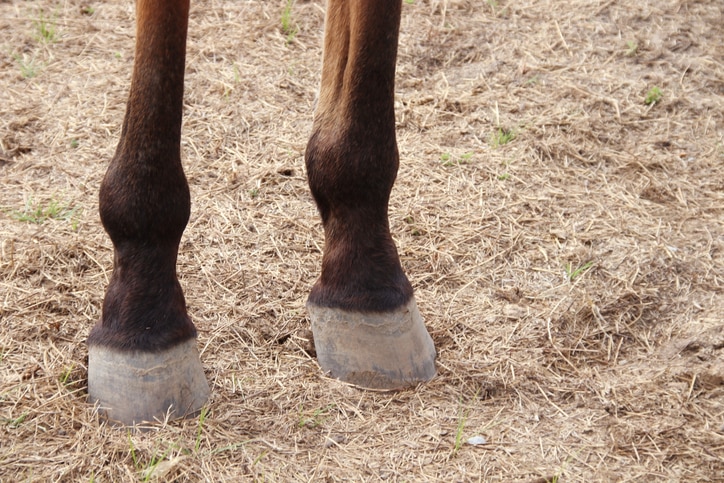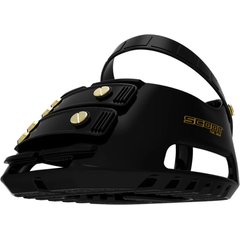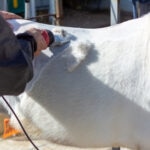A Horse Owner’s Guide to Choosing and Fitting Hoof Boots

Photo by Kanjana Wattanakungchai/iStock / Getty Images Plus via Getty Images
Hoof boots for horses are an increasingly popular way to protect horses’ hooves, either when riding or around the clock. From competitive endurance horses to pasture pals recovering from laminitis, many horses stand to benefit from a set of well-fitted hoof boots.
What Are Horse Hoof Boots?
Hoof boots are an easily removable alternative to horseshoes. Unlike horseshoes, though, hoof boots fit over the horse’s entire hoof, including the sole and frog. Hoof boots are attached with Velcro, rubber tabs, or glue, rather than nailed on like metal horseshoes.
Some horse hoof boot styles can be worn over metal shoes, such as racing plates or sliders, to provide traction and sole protection when riding on trails. Many equestrians also keep one or two hoof boots on hand as “spare tires” to replace lost horseshoes. However, hoof boots are most often seen on barefoot horses as their primary form of hoof protection when ridden.
Using hoof boots instead of shoes allows the horse’s hoof to experience natural expansion and contraction as the horse moves. Some hoof boots can be worn 24/7 to protect horses with especially sensitive hooves. Other styles are designed for protection on rocky trails or when riding long miles that would otherwise wear down a horse’s hooves.
Does My Horse Need Hoof Boots?
Not all horses need routine hoof protection. Many do well completely barefoot. Even in high-intensity sports like showjumping, some top riders—including Sweden’s 2020 gold medal Olympic team—compete without hoof protection. However, there are certain scenarios and certain horses who might benefit from wearing horse boots.
Consider the Terrain
However, if you ride your horse long distances, in snow, or on sandy, rocky trails, they’ll probably be more comfortable wearing hoof boots. With a heavy workload, even the strongest hooves can be worn down faster than they grow.
If your horse experiences hoof discomfort due to rough terrain, they may become less enthusiastic about trail riding. Some endurance rides require horses to wear either shoes or boots due to rocky, technical sections on the trail.
Comfort For Your Horse’s Natural Hoof
Horses with naturally thin, tender soles or who are transitioning to barefoot will generally benefit from boots. So will those that need pads when shod—hoof boots protect the entire sole and frog, so they’re like shoes and pads in one.
If you notice your barefoot horse stepping gingerly when crossing rocks or asphalt, get them a set of boots. It’s better to err on the side of protection, so your horse doesn’t learn to associate riding with discomfort.
Lost a Shoe? Use a Hoof Boot!
Even if your horse is shod, you may wish to keep a pair of well-fitting hoof boots in your emergency kit. Losing a shoe at a horse show doesn’t have to be the end of your event if you can slap a boot on and keep going.
Furthermore, veterinarians sometimes recommend boots for recovery from hoof injuries.
Choosing the Best Horse Hoof Boots
Different hoof boots are suitable for different purposes and different horses. A horse with laminitis, for example, needs a very different hoof boot than one tackling a 50-mile endurance ride. Many people find they need to try a few styles before they find “boot nirvana.”
Here are some well-regarded hoof boot options for various equine needs:
- Easyboot Sneakers: These are great boots for many casual riders who want a little extra hoof protection in the arena or on trails. They’re easy to apply and remove and can be fitted with studs as needed for winter traction.
- Easyboot Gloves: These boots are another endurance riding favorite. You may need a rubber mallet to get them on, but that snug fit makes Gloves ideal for horses who tend to lose boots or get pastern rubs from looser-fitting boots.
- Cavallo Entry Level Horse Boots: If you’re looking for something budget-friendly to slap on when your horse loses a shoe, these inexpensive boots will do the trick. They aren’t suitable for long miles or high-intensity riding, but they will protect your horse’s hooves until the farrier comes.
- Easyboot Clouds: These therapeutic boots are made specifically for horses recovering from an illness or injury, such as laminitis. As the name suggests, they’re heavily cushioned to comfort tender hooves.
Recommended Products
How Should Hoof Boots Fit My Horse?
Always measure your horse’s bare hooves carefully before ordering hoof boots, according to the manufacturer’s guidelines.
Ideally, measurements should be taken within two weeks after their last hoof trim. You will probably need someone else to hold your horse’s feet up while you wield the measuring tape.
There’s more work to do once the boots arrive. Each style of hoof boot—even from the same maker—will have slightly different fitting instructions. It’s important to follow the manufacturer’s directions carefully. Contact the maker directly for fitting help if you have a question not addressed online.
It can take some time to become confident in fitting hoof boots to your horse, but the time investment is well worth it to increase your horse’s comfort.
FAQs About Hoof Boots for Horses
Are hoof boots good for horses?
Every horse is an individual with individual needs. The best form of hoof protection for each horse should be chosen individually, with advice from your farrier or barefoot trimmer and veterinarian.
How long can a horse wear hoof boots?
Some horses wear hoof boots around the clock to protect sensitive hooves. However, hoof boots worn 24/7 must be removed and cleaned daily to prevent trapped dirt from causing sores. Also check to make sure the hoof boot is properly fitted to the hoof, as they can slip.
Can you ride a horse with hoof boots?
Yes, many styles of hoof boots are designed for riding, including high-intensity riding. Horses with hoof boots have competed successfully at high-level events, including the Tevis Cup.
What is the best hoof boot for laminitis?
Cushioned therapeutic boots, such as the Easyboot Cloud, are generally recommended for laminitis. Your equine veterinarian can help you choose a boot best suited for your horse’s medical status.
What is the easiest hoof boot to put on?
Hoof boots that attach with Velcro, like the Cavallo Trek, are usually easy to put on and take off.
Can a horse wear one hoof boot?
Yes, a horse can wear one hoof boot for a short time, such as after losing a metal shoe or when wearing a special soaking boot to medicate a hoof injury. Horses should not wear one hoof boot with no protection on the other three feet for extended periods, as it could unbalance their gait and increase their risk of injury.
This content was medically reviewed by Kaela Schraer, DVM.







